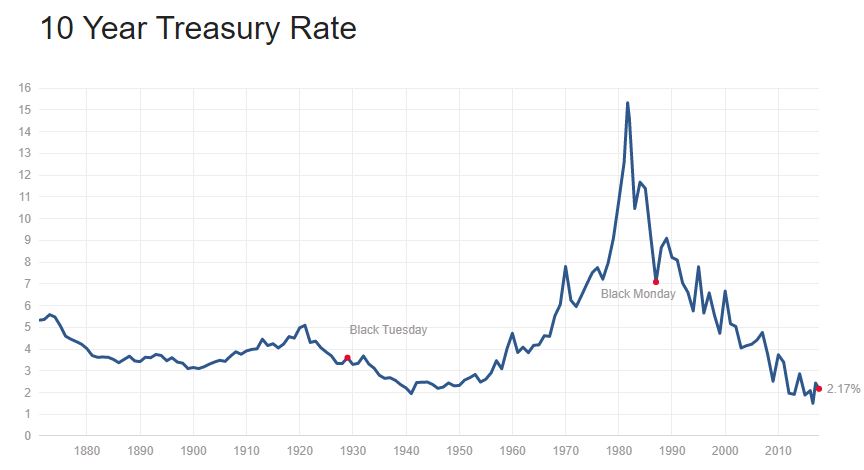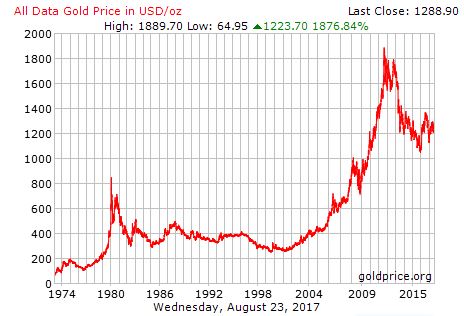In my last few articles I described the likely effects of interest rate rises in general, and in the bond market in particular.
This is relevant now, of course, because interest rates in the United States and elsewhere are beginning to rise after an eight-year period of historic low rates.
And when I say historic low rates, I don’t mean just recent history.
In January 2015, 10-year rates dropped to 1.88%, the lowest in history. Considering this, it appears that there is nowhere for rates to go but up.
We’ve already discussed bonds in those earlier articles. So, what about other asset classes, like stocks, precious metals and real estate? Are there clear relationships between their prices and interest rates?
In a word – no. There are logical arguments about how those assets should be affected by interest rates. But the actual long-term data doesn’t bear them out. Below I’ll show you what I mean.
Below is a chart from multpl.com showing the rate on 10-year U.S. treasury notes from 1880 to date. This is a good gauge of U.S. interest rates.
Compare that to the comparable long-term chart of the stock market below, as represented by the S&P 500 (data prior to 1956 has been reconstructed since the S&P 500 Index did not exist before then).
Note, that while interest rates fell more or less steadily from 1980 (when they were over 15%) to 2016 (where they reached under 2%), the stock market had several bull and bear cycles during that 36-year period. The S&P chart is a logarithmic chart so steep declines in the 1987 bear market (down 35%), the 2000-2003 bear market (down 50%) and the 2008-2009 bear market (down 50% again) don’t appear quite as shocking as they were at the time.
Still, it’s pretty clear that the two long-term graphs don’t share any persistent correlation, whether positive or negative. When interest rates drop, stocks will – do whatever they do. Same thing when rates rise.
So the answer to the question, “What will higher interest rates do to stocks?” is, – nobody knows. History is no guide. All the logical arguments have no real predictive value.
OK then, what about precious metals? Is there anything history can tell us about that?
Well, what history tells us is that it has nothing to say on the matter. Here is the long-term price of gold. In this case, the data only goes back to 1974. It was only in 1971 that the price of gold was allowed to float from its officially-pegged price, so data before that is not meaningful anyway.
Gold peaked at over $800 an ounce in 1980 (a time of historically high interest rates). It then dropped for the next six years, as interest rates were falling. So far, that would indicate a positive correlation between interest rates and gold. But gold then fluctuated in a narrow range between $300 and $400 per ounce for over 20 years, as interest rates steadily fell. So – no correlation during that period. In 2001 gold began a run that went on mostly uninterrupted from 2001 ($400) through 2011 ($1800). It then dropped by 50% over the next few years and has treaded water ever since. All while rates steadily fell.
So, like stocks there is no reliable connection between gold and interest rates.
Finally, let’s take a look at real estate. Surely there is a connection there, isn’t there?
Well, for prices of housing anyway, not as much as you would think. After rising steadily from 1980 to 2005, housing prices then famously crashed and burned, before eventually bottoming out in 2012. Meanwhile, interest rates dropped for the whole period.
In the end, there is just no telling what the effect of interest rate changes will be on any assets, other than cash in the bank and, to a lesser extent, bonds.
As a long-term investor, the best policy in the face of rising interest rates is – the same as the best policy would be in any other rate environment. That is, to manage your bond investments with an eye on rates as previously outlined; and otherwise, to diversify across several non-correlated asset classes, which could include stocks and/or gold and/or real estate, as well as others. Since they all move to their own rhythms, at almost all times there are some that are doing well even if others are not. Each of those assets must then be managed on its own to its best advantage and according to its own characteristics.
Those principles are the foundation of the ProActive Investing method. We can describe some of the outlines of the program in these short articles. The full details are in the program itself. To investigate further, I invite you to contact your local center.
This content is intended to provide educational information only. This information should not be construed as individual or customized legal, tax, financial or investment services. As each individual's situation is unique, a qualified professional should be consulted before making legal, tax, financial and investment decisions. The educational information provided in this article does not comprise any course or a part of any course that may be used as an educational credit for any certification purpose and will not prepare any User to be accredited for any licenses in any industry and will not prepare any User to get a job. Reproduced by permission from OTAcademy.com click here for Terms of Use: https://www.otacademy.com/about/terms
Editors’ Picks
AUD/USD: Extra gains in the pipeline above 0.6520

AUD/USD partially reversed Tuesday’s strong pullback and regained the 0.6500 barrier and beyond in response to the sharp post-FOMC pullback in the Greenback on Wednesday.
EUR/USD meets support around 1.0650

EUR/USD managed to surpass the key 1.0700 barrier in response to the intense retracement in the US Dollar in the wake of the Fed’s interest rate decision and Chair Powell’s press conference.
Gold surpasses $2,300 as Dollar tumbles

The precious metal maintains its constructive stance and trespasses the $2,300 region on Wednesday after the Federal Reserve left its FFTR intact, matching market expectations.
Bitcoin price reclaims $59K as Fed leaves rates unchanged

The market was at the edge of its seat on Wednesday to see whether the US Federal Reserve (Fed) would cut interest rates during the Federal Open Market Committee (FOMC) meeting.
The market welcomes the Fed's statement

The market has welcomed the Fed statement, and the S&P 500 is higher in its aftermath, the dollar is lower and Treasury yields are falling. There is still only one cut priced in by the Fed.
RECOMMENDED LESSONS
Making money in forex is easy if you know how the bankers trade!
Discover how to make money in forex is easy if you know how the bankers trade!
5 Forex News Events You Need To Know
In the fast moving world of currency markets, it is extremely important for new traders to know the list of important forex news...
Top 10 Chart Patterns Every Trader Should Know
Chart patterns are one of the most effective trading tools for a trader. They are pure price-action, and form on the basis of underlying buying and...
7 Ways to Avoid Forex Scams
The forex industry is recently seeing more and more scams. Here are 7 ways to avoid losing your money in such scams: Forex scams are becoming frequent. Michael Greenberg reports on luxurious expenses, including a submarine bought from the money taken from forex traders. Here’s another report of a forex fraud. So, how can we avoid falling in such forex scams?
What Are the 10 Fatal Mistakes Traders Make
Trading is exciting. Trading is hard. Trading is extremely hard. Some say that it takes more than 10,000 hours to master. Others believe that trading is the way to quick riches. They might be both wrong. What is important to know that no matter how experienced you are, mistakes will be part of the trading process.




